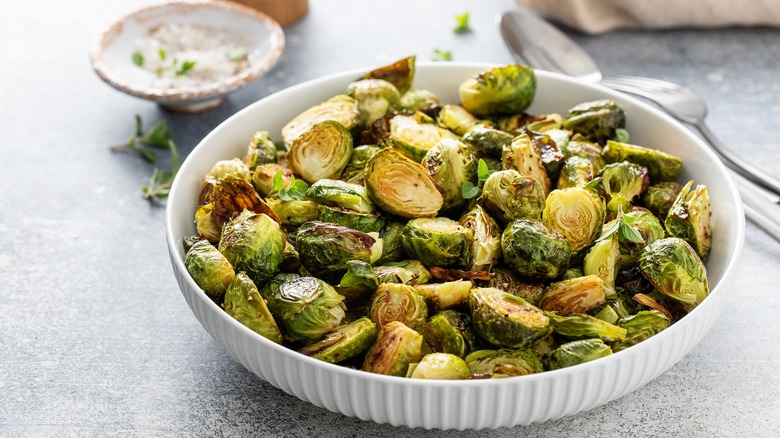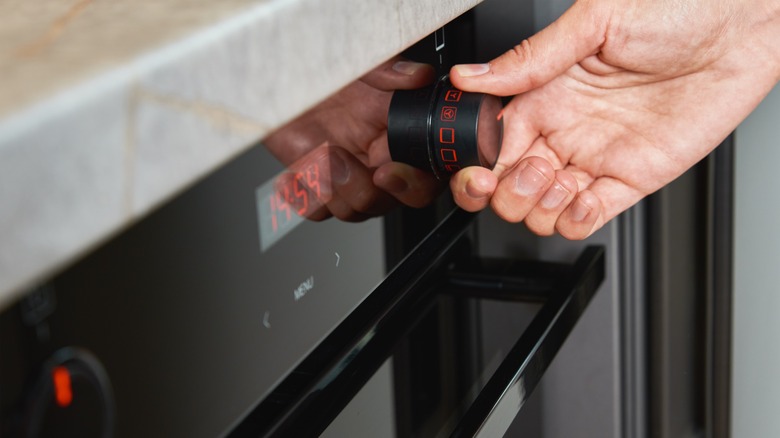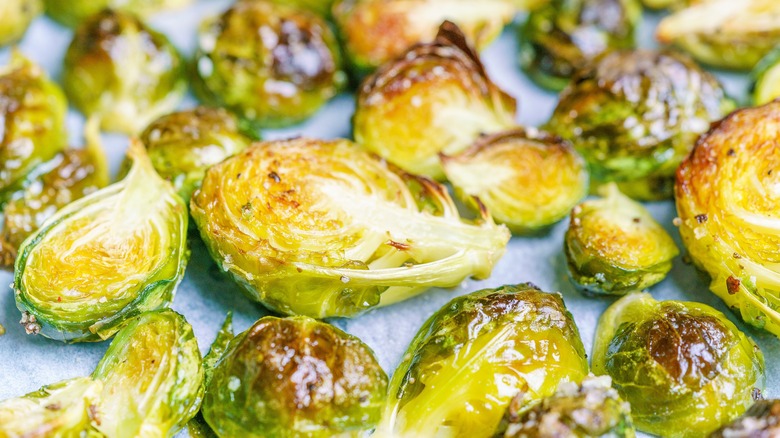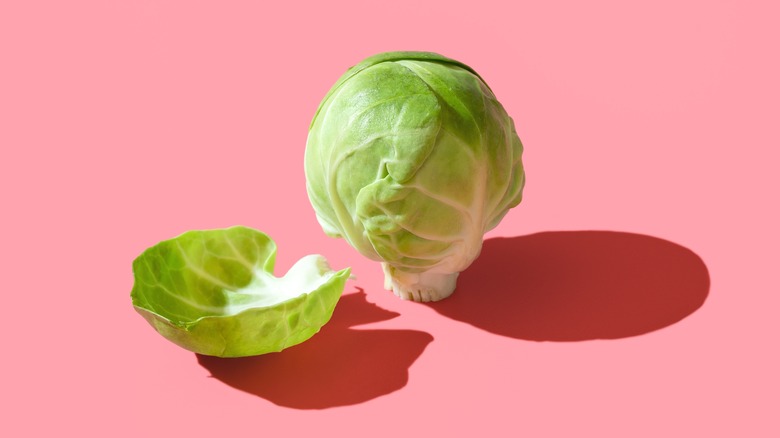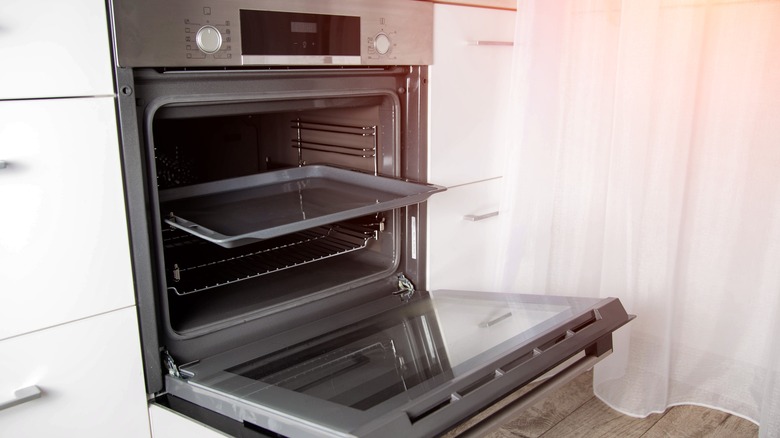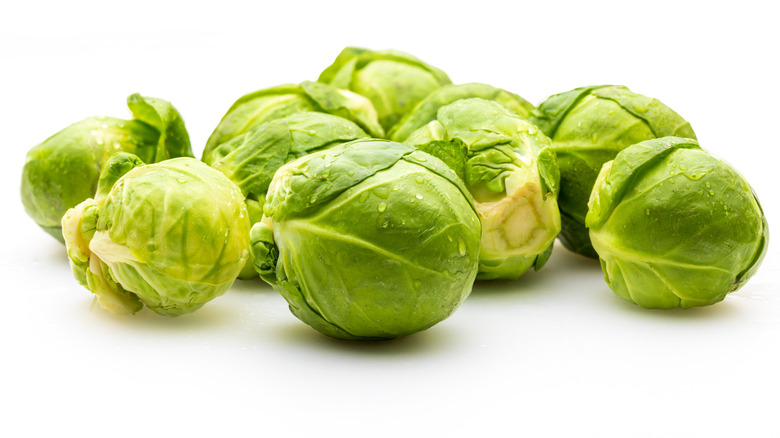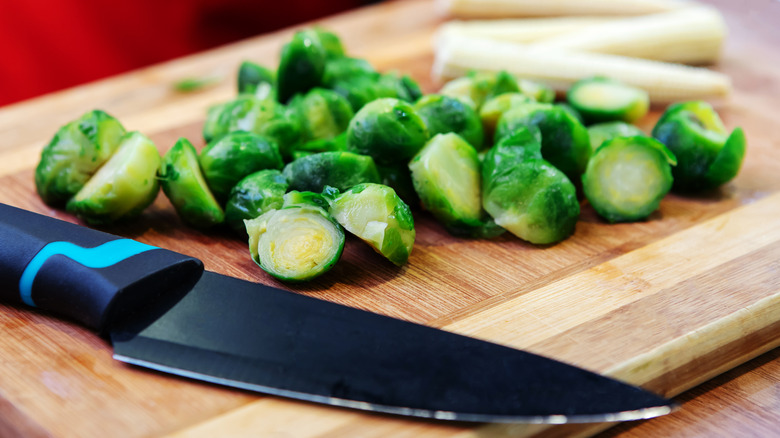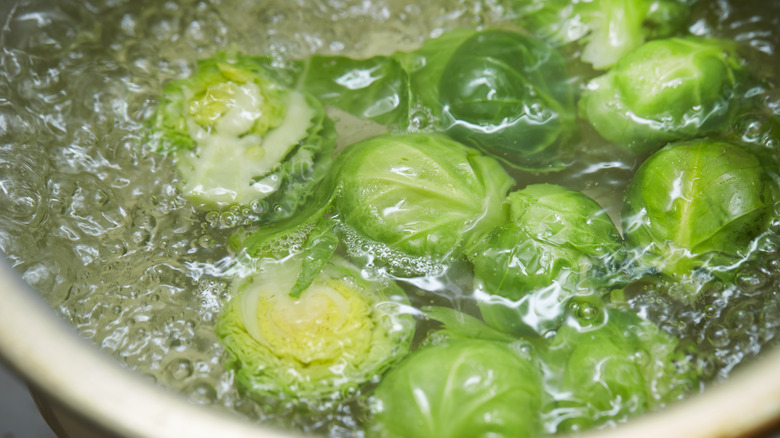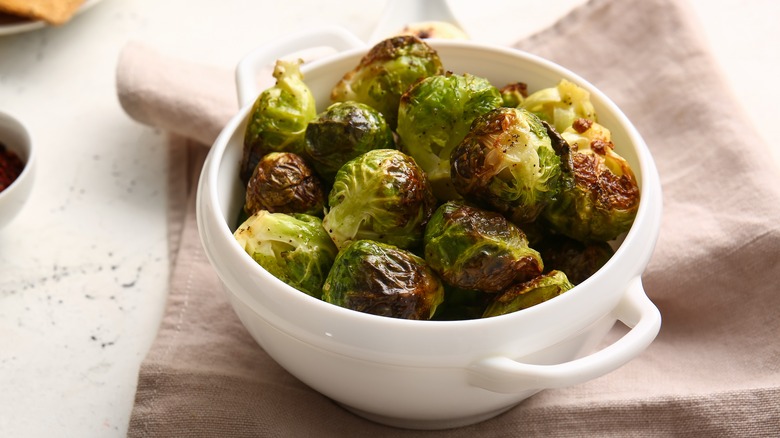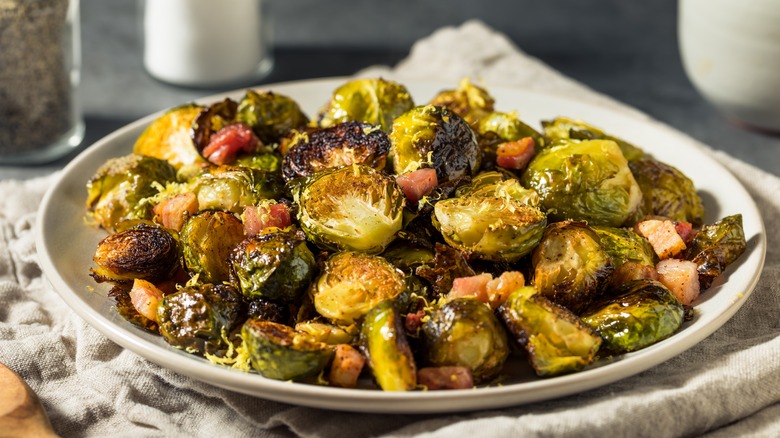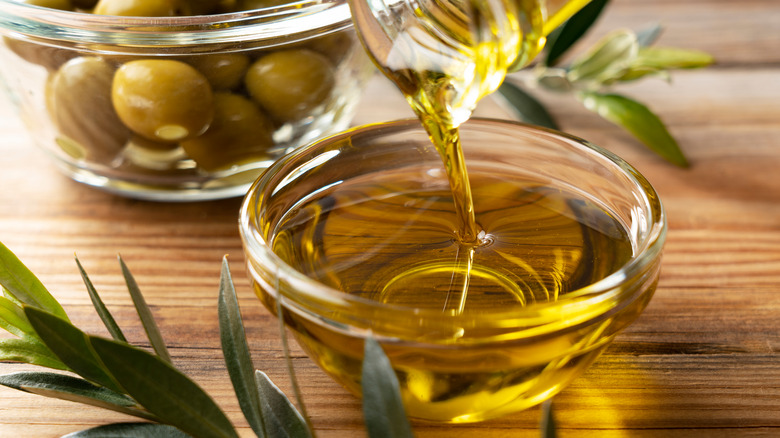Mistakes You Are Making When Cooking Brussels Sprouts
Few foods have made quite the comeback in our culture over the past few generations as Brussels sprouts have. The smaller, leafy cousin of the cabbage was often a food item we would turn our noses up to as kids. But nowadays some of us will gladly eat an entire bowl of sprouts like they are candy. So, what happened that made us make a total 180-degree turn on our opinions? When made correctly, Brussels sprouts can truly shine with that perfect marriage of having both a nice, crispy texture and a perfect salty taste. But as always, when things can go right, there is also the possibility that things can go oh, so wrong.
If you stumbled upon top-notch Brussels sprouts at a dinner party or restaurant and you are wondering how to recreate the dish yourself, there are a few common pitfalls you need to be aware of. As simple as they are to make, they are also easy to mess up as well. They can quickly turn into the smelly dish of our childhood nightmares rather than a sophisticated and addicting cruciferous vegetable. Here now are some of the most common mistakes people make when preparing Brussels sprouts, and how to avoid making them.
Cooking at a low heat
Let's get one important step to follow when making Brussels sprouts clear from the get-go: the best way to prepare Brussels sprouts is to roast them in your oven. In fact, one of the biggest mistakes you can make with Brussels sprouts is trying to steam or microwave them. To perfectly oven-roast Brussels sprouts and caramelize them for that heavenly flavor, proper prep is essential. The basic steps you want to follow involve slicing them in half lengthwise and popping them in the oven on a baking sheet for a set amount of time. And as is the case with any other dish that is cooked in the oven, the temperature can play a big factor.
Some dishes are best prepared with a low and slow mentality, but not Brussels sprouts. To get them nice and crispy, you are going to want to crank the temperature up fairly high. Many recipes will suggest around 400 degrees Fahrenheit. Brussels sprouts are a dense vegetable, so they are going to need as much heat as possible to cook all the way through — especially if you want them nice and crispy when they're done.
Not placing them cut-side down
Most of the time when you are roasting vegetables in the oven, the side that is placed on the baking sheet does not necessarily matter. Or, you may read instructions to flip or stir the ingredients once or twice as it cooks. When it comes to Brussels sprouts, however, there is a specific way to prep the vegetable on the sheet that will optimize its flavor and texture.
The trick involves slicing the Brussels sprout in half and then laying the pieces down on the sheet cut-side down. You do not want to place whole Brussels sprouts in the oven, especially if they are larger in size, because the round shape makes for a small surface area to come into contact with the pan. The rounded, non-cut side is rather dense, so having those sides facing up will help them to cook quicker and more evenly. On top of that, the flat side coming into contact with the hot pan will help to make them nice and crispy. There is no need to shake or stir the Brussels sprouts at any point while they are cooking; just let them be and let your oven do all of the work.
Throwing out the outer leaves
Brussels sprouts are cruciferous vegetables, a family of foods that includes broccoli, turnips, cauliflower, and kale, among others. Cruciferous vegetables are packed with vitamins and nutrients that may reduce the risk of certain cancers (via the National Cancer Institute). Part of what makes Brussels sprouts so good for you health-wise can be found in its leaves, which, like cabbage, are packed into layers.
Between slicing, tossing, and prepping, you may notice a few of the outermost layers of leaves of the Brussels sprouts begin to fall off. Whatever you do, do not throw them out. In addition to retaining as many nutrient-dense leaves as possible, tossing the fallen leaves in with the Brussels sprouts on the baking sheet will make for some nice texture in the final dish. Those loose leaves will crisp up in the oven, and you may find yourself fighting with everyone else over who gets to eat the crispy leaves. You can even make creative dishes out of the individual leaves like a sauté with baby spinach.
Not preheating your baking tray
Cooking a great meal at home has just as much to do with the tools you are using as it does with the ingredients that go into your favorite dish. Not only do you need sturdy tools that can get the job done, but you want to make sure you are fully optimizing those kitchen gadgets to their full potential. You do not need anything fancy or intricate when making Brussels sprouts, but there is one step you should make sure you take in order to get the best roast possible.
As you heat up your oven, throw in the baking sheet you plan on using and let it preheat. Once the oven has reached its temperature, carefully add the Brussels sprouts to the preheated sheet making sure they are cut side down. Be safe handling the hot pan and use a spatula if you have to flip them over. The Brussels sprouts will get right to work by roasting the moment they make contact with the pan, and you will get an even better crispy edge once they are done.
Not adjusting for different-sized sprouts
Brussels sprouts, like any other vegetable, come in all different sizes. If you take a look in your grocery store, you may notice prepackaged bags of small or medium Brussels sprouts, but the produce section may also have loose Brussels sprouts that are much larger. No matter what size vegetable you are used to working with, it is important to make sure you are adjusting accordingly if you are cooking smaller or larger varieties.
Brussels sprouts are a dense vegetable, so the larger they are, the more time they may need to roast in the oven. Similarly, the smaller they are, the quicker they cook. So you may realize that you do not even need to slice all of them in half depending on how small they are.
You may also notice a difference in flavor. Larger Brussels sprouts tend to be on the bitter side of the scale. So, if you are not used to the flavor or you are preparing food for some pickier eaters, you may want to opt for smaller ones to start. If you do select the larger sprouts, consider additional seasonings that may help to balance out the more bitter flavor.
Over or under-trimming
If you come across Brussels sprouts before they are harvested, you will notice that they grow on stalks, with each individual sprout growing from a stem off of that stalk. In fact, some grocery stores will sell Brussels sprouts still on the stalk, but you can usually find just the sprouts being sold loose or in packages. No matter how you buy them, you will notice that some of this stem is still attached to the sprout, and it is important to remove that extra bit of stem prior to cooking.
However, you do not want to over-trim your sprouts. If you remove too much of the stem, you can cause all of the leaves to fall off of the sprout. While a few straggling leaves are a great addition to the dish, you still want the sprouts themselves to retain the majority of their leaves. You want to aim to trim just the bottom piece of the stem and avoid actually slicing into the sprout itself. Do not under-trim either, since you do not want to eat the stem. It is perfectly safe, but won't taste quite as pleasant.
Steaming or boiling them
Many of us have less-than-pleasant memories of Brussels sprouts from childhood, which usually boils down to, pun intended, the cooking method. Our parents and grandparents did these delightful sprouts an injustice if they boiled them. Never, under any circumstances, should you be steaming or boiling your Brussels sprouts. It is virtually night and day what they can look, smell, and taste like when you boil them versus roasting them. The number one way to prepare Brussels sprouts is roasting them, which better optimizes the vegetable's taste and texture.
You do not need a heavy amount of seasoning either when roasting Brussels sprouts. Just olive oil and salt will do if you are just starting out. There are some recipes that may call for blanching your Brussels sprouts prior to roasting. You can try these, but always make sure you're not just tossing whole Brussels sprouts into a pot of boiling water before serving them. It is a surefire way to wind up with mushy and smelly sprouts, which no one enjoys.
Roasting too long or too little
Timing is an important step in any dish you are preparing, and that certainly includes Brussels sprouts. It is an easy vegetable to roast, but if you get the timing wrong it can totally throw off the taste and texture you were trying to achieve. If you roast them for too long, you obviously run the risk of burning them. But if you take them out of the oven too soon, you may wind up with undercooked sprouts that are quite tough to chew on. And while undercooked or even raw Brussels sprouts are safe to eat, it is definitely not the level of doneness we want to strive for (via Healthline). So, what is that goldilocks time we are looking for?
In general, most Brussels sprouts recipes will advise an oven temperature of at least 400 degrees Fahrenheit, which will come out to approximately 30 minutes of roasting in the oven. If your oven is slightly below that temperature, add a few minutes to the cooking time. Make sure to check your Brussels sprouts regularly during cooking to pull them out early if needed.
Not adding any seasonings or extra ingredients
Brussels sprouts are surprisingly tasty with just olive oil and salt as your two additional ingredients. But they are also quite versatile in that they can take on a ton of added flavor, meaning your imagination can run wild when deciding how to season them. If all you ever do is toss your roasted Brussels sprouts in salt and call it a day, you are potentially missing out on some home run recipes.
There are lots of different recipes out there to try, including Maple-Dijon Brussels Sprouts and Brussels Sprouts with Bacon. Brussels sprouts also taste wonderful when tossed in some sort of soy glaze. Also, don't knock cheesy Brussels sprouts until you have tried them. Like many other vegetables, Brussels sprouts are not a one-trick pony when it comes to flavor. Experiment with different spices, glazes, and added ingredients to see what combination works best for you.
Not using enough oil
One of the most important steps to remember is to coat your Brussels sprouts in plenty of olive oil before tossing them into the oven. Of course, you do not want to absolutely drown your sprouts to the point where they cannot cook properly at all. But this is one of those situations where skimping on olive oil can actually have a noticeable difference in the final results.
An easy way to make sure each Brussels sprout is properly coated in olive oil is to drizzle some in a mixing bowl with your halved sprouts and toss until evenly covered. For added measure, you can also pour a thin layer onto your baking sheet to make sure each sprout comes into contact with enough oil to crisp up well. The oil will also help roast the sprouts in a way that optimizes the caramelization process, which is an essential component in bringing out the sprout's natural flavors.
